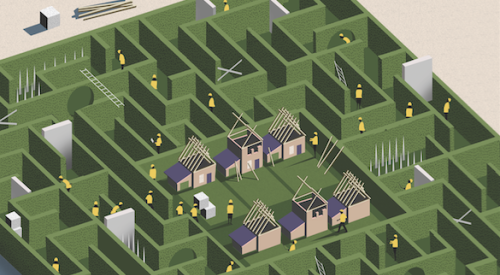The researcher, Louis H. Masotti, professor emeritus of real estate and urban development at Northwestern University, analyzed the costs borne by builders in the process of complying with local requirements. Included were city fees, required land deductions, the expense of meeting local development standards and the financial cost of carrying a project during the review process.
The results are striking, particularly in a state where demand for housing is acute. Based on an average sales price of $371,339 in Carlsbad for a detached single family home on a 7000 square foot lot with 2600 square feet of living space, Masotti found that these items tack-on an average of $96,301 per home or 26% of the cost of the Smith's home.
For Paul Tryon, executive vice president of the San Diego BIA, the findings highlight the need for changes in the way communities are built. The review process and the way growing communities pay for new infrastructure needs, he says, to be entirely rethought. The current way of doing things "is costly and burdensome. And its affect on the region socially and economically are very significant."
The study shows that for each additional $1,000 increase in the price of a new home, 1,000 households in Southern California lose the ability to afford a home. The human side of the cost of regulation then becomes the approximately 96,000 households that would have otherwise been able to afford the fictional Smith family home.
In performing the study, The Economic Impact of Regulation: The Case of the Smith Family House, Masotti was careful to gauge not only the direct cost of fees collected at various points of the building process, but also the indirect costs associated with local Carlsbad building ordinances. On the direct side, building permit fees amounted to $40,892. A $273 application fee and a $721 fee for final map recordation brought the total to $41,886.
Harder to quantify were the costs of building requirements imposed by a range of local ordinances, including:
Aside from the mandates of regulations, the time factor is also significant. According to the study, the total time elapsed--from request for land rezoning to building permit issuance--is three to five years. The review and adoption of a master planned community of 1,000 homes takes approximately two years in Carlsbad. Another eight to 12 months is required for tentative tract approval of a proposed subdivision and another 10-12 months for final map approval of proposed neighborhoods with more than 50 homes. Assuming 10% interest for each month of review time, $25,100 of the price of the Smith family house can be attributed to land-carrying costs.
Tryon says Carlsbad was singled out for study because, as a fast-growing bedroom community, it is typical of most communities in San Diego County. And the association is sponsoring two similar studies currently underway in other parts of San Diego County with results due out in coming weeks, he says. The goal is to continue to raise awareness of the burden of current development regulations and how they contribute to California's ongoing housing problem.
"The way we do things now," says Tryon. "is dysfunctional."












